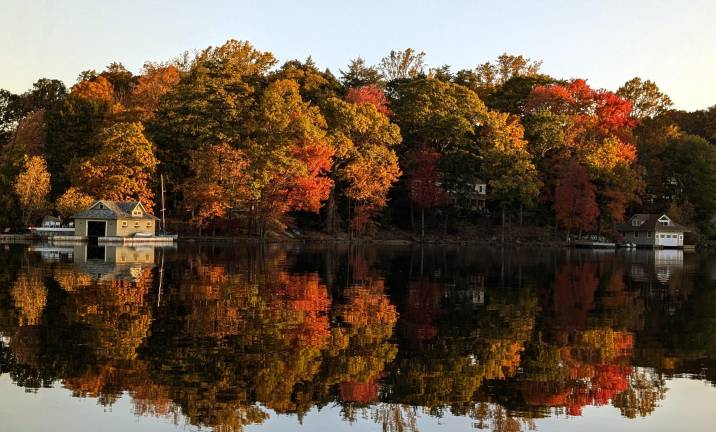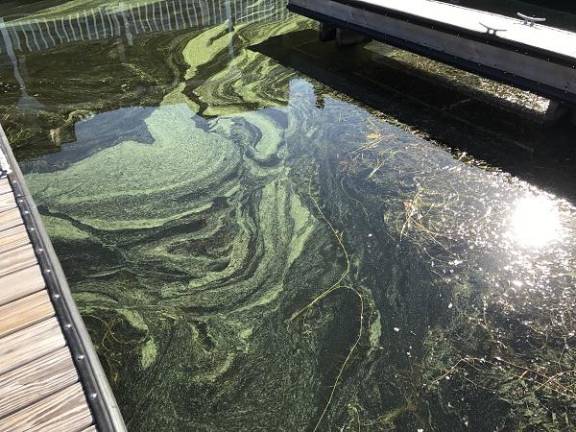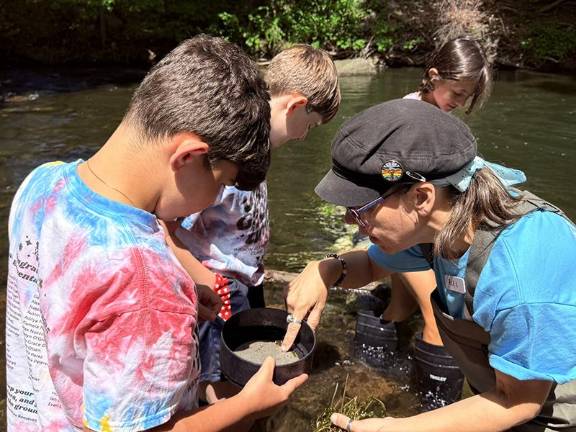Fall is a busy time on Lake Hopatcong
Lake Hopatcong. Lake Hopatcong is recovering from recent harmful algal blooms driven by nutrient-laden runoff and warming waters through coordinated remediation and education efforts by scientists, governments, and local organizations, while school programs teach students how development and behavior affect the lake’s ecology.



From harmful algal bloom remediation efforts to educating area students about the lake’s ecology, Lake Hopatcong is humming with activity this fall.
“For decades, the issue at Lake Hopatcong was aquatic plants due to the sun shining through clear water and hitting sediment,” said Princeton Hydro’s Senior Technical Director of Ecological Services Dr. Fred Lubnow. “In June of 2019, we experienced a series of intense storms followed by sunny weather that resulted in the watershed being washed of nutrients and setting the lake up for a bloom of a type of algae called cyanobacteria, which produce cyanotoxins. The storms were bad enough to funnel all the nutrients from the watershed into the lake but not strong enough to flush them out of the lake. This created harmful algal blooms lake wide.”
The nutrients responsible for the blooms are predominantly phosphorus and nitrogen from things such as fertilizers, exposed dirt, pet, goose waste and septic leaching. In fact, Jefferson Township is exploring the feasibility of installing sewers to lower the phosphorus load into the lake.
“Lakes naturally age through a process called eutrophication and they will become more productive and have more algae and plants over a long time,” said Lubnow, who has been studying conditions in New Jersey’s largest lake since 1993. “The process we are dealing with is called cultural eutrophication, which means it is accelerated. From about the 1950s through the 80s, a lot of development took place in the watershed without any measures to reduce the nutrients going in, so something that may have taken 100 years to fuel the algal blooms has taken considerably less time.”
Also contributing to the growth of the greenish-blue cyanobacteria blooms, Lubnow said, is a statistically significant increase in summer water temperatures, especially in shallow areas.
The toxins produced can harm people, animals, aquatic ecosystems and just about anything else related to the lake.
“Since 2019, I have heard of people complain of feeling ill, but I have not seen any documented cases of people getting sick from the harmful algal blooms,” said Lubnow. “There were some reports of dog deaths, as dogs are more sensitive.”
Remediation efforts
“Last fall, we did an alum treatment through a state Department of Environmental Protection (DEP) grant to inactivate internal phosphorus load that comes up from deep waters, which has helped to curb some of the blooms,” Lubnow said. “We did proactive near-shore treatments through a U.S. Army Corps. of Engineers program in the spring using licensed pesticides and have seen good results. As well, we used various products to drag the algae to the bottom so it can be broken down by bacteria in mud.”
Once all the data is in from those near-shore projects, Lubnow and others will conduct a cost benefit analysis as to each treatment’s cost per acre and benefit associated with it. There is also an effort underway to identify where the resting/overwintering spores are and treat accordingly.
Keeping goose feces, high in phosphorus and nitrogen, away from the lake also is helpful.
“Geese are all over the place and poop a lot,” Lubnow said. “The Lake Hopatcong Commission has a goose management subcommittee focusing on letting people know what to do about the geese, not feeding them, and installing knee-high vegetative buffers on shorelines and they have been working with Fish and Wildlife for egg addling.”
Joint effort
With organizations such as the Lake Hopatcong Commission, Lake Hopatcong Foundation, DEP, Princeton Hydro and others, preserving the ecological health of the lake is a joint effort.
“We work closely with a lot of people,” Lubnow said, “I attend monthly Lake Hopatcong Commission meetings along with members from the four lake municipalities, both counties, the DEP and members of the public. We also work with Lake Hopatcong Foundation. The harmful algal bloom problem has dissipated since 2019 and we are optimistic that trend will continue.”
Floating classroom
As the blooms are dissipating, knowledge about the lake is increasing, thanks in no small part to the Lake Hopatcong Foundation. A nonprofit organization dedicated to protecting the lake by bringing together public and private resources – its education arm works with area school districts.
“We have been educating elementary schools, specifically fourth graders, for over a decade,” said Lake Hopatcong Foundation Development Director Caitlin Doran. “Our field trip program has grown in that time to service over 2,000 students from area schools. Free for the elementary schools in the four towns around the lake, students go on nature hike, kick up dirt in the water to indicate water health, learn how development affects the water and then enjoy our floating classroom, which is a 40-foot pontoon boat on which they learn about the history and ecology of the lake.”
With the success of the spring elementary school program through grants and fundraising, the foundation is now in year two of its fall high school program.
“It is more science-based and introduces the older students to lake ecology and the idea they can pursue environmental education,” said Doran. “Six schools participated this year, up from four last year, and this winter in-school education on lake ecology will begin.”
One positive outcome of the harmful algal blooms was that the lake community became even closer.
“That was a watershed moment that brought the community together to work collaboratively to mitigate harmful algal blooms and protect the lake,” Doran explained. “The blooms threatened the economy, environment and recreation and our enviroscape watershed model shows how stormwater runoff can move fertilizer from your lawn into the lake and contribute to a harmful algal bloom. We think it is important for kids to make that connection.”

